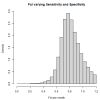Human and Livestock Surveillance Revealed the Circulation of Rift Valley Fever Virus in Agnam, Northern Senegal, 2021
- PMID: 36828503
- PMCID: PMC9962223
- DOI: 10.3390/tropicalmed8020087
Human and Livestock Surveillance Revealed the Circulation of Rift Valley Fever Virus in Agnam, Northern Senegal, 2021
Abstract
The mosquito-borne disease caused by the Rift Valley Fever Virus (RVFV) is a viral hemorrhagic fever that affects humans and animals. In 1987, RVFV emerged in Mauritania, which caused the first RVFV outbreak in West Africa. This outbreak was shortly followed by reported cases in humans and livestock in Senegal. Animal trade practices with neighboring Mauritania suggest northern regions of Senegal are at high risk for RVF. In this study, we aim to conduct a molecular and serological survey of RVFV in humans and livestock in Agnam (northeastern Senegal) by RT-PCR (reverse transcription real-time polymerase chain reaction) and ELISA (Enzyme-Linked Immunosorbent Assay), respectively. Of the two hundred fifty-five human sera, one (0.39%) tested RVFV IgM positive, while fifty-three (20.78%) tested positive for RVFV IgG. For animal monitoring, out of 30 sheep recorded and sampled over the study period, 20 (66.67%) showed seroconversion to RVFV IgG antibodies, notably during the rainy season. The presence of antibodies increased significantly with age in both groups (p < 0.05), as the force of RVF infection (FOI), increased by 16.05% per year for humans and by 80.4% per month for livestock sheep. This study supports the usefulness of setting up a One Health survey for RVF management.
Keywords: Rift Valley Fever Virus; humans; livestock; northeastern Senegal; survey.
Conflict of interest statement
The authors declare no conflict of interest. The funders had no role in the design of the study; in the collection, analysis, or interpretation of data; in the writing of the manuscript; or in the decision to publish the results.
Figures




Similar articles
-
Molecular and serological studies on the Rift Valley fever outbreak in Mauritania in 2010.Transbound Emerg Dis. 2013 Nov;60 Suppl 2:31-9. doi: 10.1111/tbed.12142. Transbound Emerg Dis. 2013. PMID: 24589099
-
Inter-epidemic Rift Valley fever virus infection incidence and risks for zoonotic spillover in northern Tanzania.PLoS Negl Trop Dis. 2022 Oct 28;16(10):e0010871. doi: 10.1371/journal.pntd.0010871. eCollection 2022 Oct. PLoS Negl Trop Dis. 2022. PMID: 36306281 Free PMC article.
-
Rift Valley fever among domestic animals in the recent West African outbreak.Res Virol. 1989 Jan-Feb;140(1):67-77. doi: 10.1016/s0923-2516(89)80086-x. Res Virol. 1989. PMID: 2711047
-
Sporadic Rift Valley Fever Outbreaks in Humans and Animals in Uganda, October 2017-January 2018.J Environ Public Health. 2021 Sep 20;2021:8881191. doi: 10.1155/2021/8881191. eCollection 2021. J Environ Public Health. 2021. PMID: 34594384 Free PMC article.
-
Rift Valley fever in West Africa: A zoonotic disease with multiple socio-economic consequences.One Health. 2023 Jun 14;17:100583. doi: 10.1016/j.onehlt.2023.100583. eCollection 2023 Dec. One Health. 2023. PMID: 37664171 Free PMC article. Review.
Cited by
-
Research trends in Rift Valley fever virus: a bibliometric analysis from 1936 to 2024.Front Vet Sci. 2025 Jul 9;12:1611642. doi: 10.3389/fvets.2025.1611642. eCollection 2025. Front Vet Sci. 2025. PMID: 40703920 Free PMC article.
-
Re-Emergence of Rift Valley Fever Virus Lineage H in Senegal in 2022: In Vitro Characterization and Impact on Its Global Emergence in West Africa.Viruses. 2024 Jun 25;16(7):1018. doi: 10.3390/v16071018. Viruses. 2024. PMID: 39066182 Free PMC article.
-
Emerging Diseases/Viruses Prevention, Control, Surveillance, and One Health.Trop Med Infect Dis. 2023 Apr 29;8(5):257. doi: 10.3390/tropicalmed8050257. Trop Med Infect Dis. 2023. PMID: 37235305 Free PMC article.
-
The Adaptive Immune Response against Bunyavirales.Viruses. 2024 Mar 21;16(3):483. doi: 10.3390/v16030483. Viruses. 2024. PMID: 38543848 Free PMC article. Review.
-
Large-Scale Serological Survey of Crimean-Congo Hemorrhagic Fever Virus and Rift Valley Fever Virus in Small Ruminants in Senegal.Pathogens. 2024 Aug 15;13(8):689. doi: 10.3390/pathogens13080689. Pathogens. 2024. PMID: 39204289 Free PMC article.
References
-
- Daubney R., Hudson J.R. Enzootic hepatitis or Rift Valley Fever. An undescribed virus disease of sheep cattle and man from East Africa. J. Pathol. Bacteriol. 1931;34:545–579. doi: 10.1002/path.1700340418. - DOI
-
- Ba Y., Sall A.A., Diallo D., Mondo M., Girault L., Dia I., Diallo M. Re-emergence of Rift Valley Fever virus in Barkedji (Senegal, West Africa) in 2002-2003: Identification of new vectors and epidemiological implications. J. Am. Mosq. Control Assoc. 2012;28:170–178. doi: 10.2987/12-5725.1. - DOI - PubMed
-
- Bob N.S., Barry M.A., Diagne M.M., Faye M., Ndione M.H.D., Diallo A., Diop M., Diop B., Faye O., Loucoubar C., et al. Detection of Rift Valley Fever Virus Lineage H from South Africa through Syndromic Sentinel Surveillance Network in Senegal. Open Forum Infect. Dis. 2021;9:ofab655. doi: 10.1093/ofid/ofab655. - DOI - PMC - PubMed
Grants and funding
LinkOut - more resources
Full Text Sources

